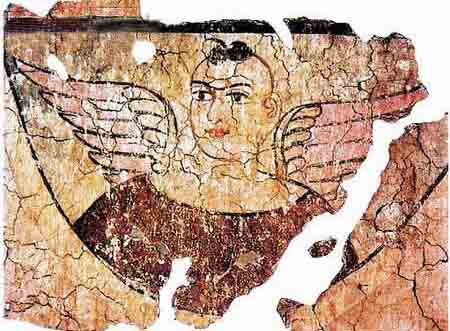Silk Road angels reveal cultural exchanges with foreign civilizations

Mural of “winged angels” in Miran
Many people believed that exchanges between Eastern and Western arts began when the Italian Jesuit priest Matteo Ricci (1552-1610) came to China. But recent research from comparative civilization studies and art archaeology in the 21st century show exchanges as early as the Silk Road period.
Historical materials demonstrate that monks, diplomatic officials, religious figures, artists and businessmen from the East and West passed by on the way to the Dunhuang region or gathered in Miran (an ancient oasis town located on the southern rim of the Taklamakan Desert in the Xinjiang Uyghur Autonomous Region) over a period of about ten centuries. The period spans from the year of 138, when Chinese official and diplomat Zhang Qian explored the way from Central China to the Western world, to 1096 when the first Crusades began.
At this junction, Buddhism, Christianity, Nestorianism, and Zoroastrianism cultures, and Chinese Confucianism and Taoism cultures interacted with each other, forming the first extensive exchange in the art history of the East and West.
Cultural exchanges along the Silk Road greatly influenced Chinese traditional painting arts, including themes, composition and other aspects. The image of the “Silk Road angel” is one example.
The “Silk Road angel” cave images were first discovered in ancient Qiuci, where intense cultural exchanges between China and the outside world took place. Qiuci, located south of the Tianshan Mountains, was a center of Buddhism that was home to large quantities of grottoes.
In December 1906, Marc Aurel Stein (1862-1943) came to the Thousand Buddha Caves in Lop No, Miran and Kuqa to search for Buddhist statues, wall paintings, and frescoes. Here he saw the image of angels with wings for the first time.
These angel images were a re-creation based on the Western “winged angel.” In the West, winged angels were more childlike, but in Miran and Kuqa they were grown men. Then in Dunhuang, these angel images further developed into female angels, the Flying Apsaras, some of which had the posture of a singing or dancing woman. Each of them holds a musical instrument, which distinguished them from the Flying Apsaras in India.
Though the musical instruments in their hands were mostly Western plucked string instruments, they were depicted in more of the Chinese style, bearing the characteristics of Chinese ink and wash paintings.
The development from the “winged angel” in Miran to the Flying Apsaras in Dunhuang represented a change from mythological art to religious art, increased aesthetic values and religious significance, as well as an innovation in cross-cultural exchanges.
Fang Hanwen is from the School of Humanity at Soochow University.
